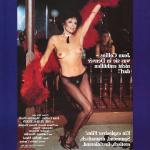B-films during the studio era often resonate decades later because they explore issues and themes not found in higher-budget pictures. Robert Florey, widely acclaimed as the best director working in major studio B-films during this period, crafted an intriguing, taut thriller. Anna May Wong overcame Hollywood’s practice at the time of casting white actors to play Asian roles and became its first, and a leading, Asian-American movie star in the 1920s through the late 1930s. “Daughter of Shanghai” was more truly Wong’s personal vehicle than any of her other films. In the story she uncovers the smuggling of illegal aliens through San Francisco’s Chinatown, cooperating with costar Philip Ahn as the first Asian G-man of the American cinema.
The edgy satire (as written by director Stanley Kubrick, Peter George, and Terry Southern) and outrageously funny performances (including three from Peter Sellers) have kept “Dr. Strangelove” fresh and entertaining for decades. A U.S. bomber on a routine flight pattern near the Soviet Union receives orders to drop its nuclear payload on the “Rooskies” and turn the Cold War into a hot one. The orders were given by the highly paranoid Gen. Jack D. Ripper (Sterling Hayden) to stem a Communist plot in which Americans were being sapped of their precious bodily fluids. Meanwhile, the president (Sellers again) seeks guidance from his top Pentagon advisors, including a war-mongering general (George C. Scott). The plot thickens when the Soviet ambassador (Peter Bull) informs the Americans of the latest Soviet weapons technology: a “Doomsday Machine” that will destroy the entire world if the Russians are attacked. But the former Nazi Dr. Strangelove (Sellers yet again) has an ingenious plan for surviving a potential nuclear holocaust. Kubrick, Sellers and the screenwriters were nominated for Oscars, but lost out to “My Fair Lady.” The film did bring home several BAFTA Awards in the U.K.
Film melodrama comes in many variations, but director Douglas Sirk’s style of domestic melodrama is marked by stylized interiors and use of mirrors, where the role of photography is crucial, with exquisite use of primary colors and camera angles to convey emotion and mood. During the 1950s, the Universal team of Sirk, producers Ross Hunter and Albert Zugsmith, cinematographer Russell Metty and composer Frank Skinner, released a series of glossy, often deliriously flamboyant “women’s picture” melodramas, including “All That Heaven Allows,” “Magnificent Obsession,” “Written on the Wind” and “Imitation of Life.” The often-lurid plots in these films may have seemed laughable and unrealistic, but the emotional impact on audiences packed a wallop that led to major box-office bonanzas for Universal. Sirk’s last American film, “Imitation of Life,” is based on the Fannie Hurst novel about two mothers (one white and one African-American) and their daughters (one white and one who wishes to pass for white). Sirk’s 1959 version (with Lana Turner and Juanita Moore as the mothers) offers a telling contrast to the more restrained melodramatic style used by John Stahl in the 1934 version (previously selected for the registry), starring Claudette Colbert and Louise Beavers. One can also spot in Sirk’s film fascinating glimpses at the evolving social standards and mores the country had undergone in the 25 years that elapsed between the two films, particularly in the characters of Moore and her daughter Susan Kohner. However, New York Times reviewers did not note much difference in the two versions. The paper’s 1934 reviewer called the film “the most shameless tearjerker of the fall” while Bosley Crowther’s 1959 review proved little different: “It is the most shameless tearjerker in a couple of years.” Sirk’s version ends with Mahalia Jackson singing “Trouble of the World” during the penultimate funeral scene and daughter Susan Kohner begging forgiveness while hugging her dead mother’s casket.
Meanwhile, production of teen films, as well as other related mid-budget movie genres like the romcom, basically cratered as Hollywood diverged into big-budget superhero flicks and small, quiet indies. There were outliers – the breezy Easy A in 2010, in which Emma Stone turned fixation on a teen girl’s perceived sexual availability into a riff on The Scarlet Letter, grossed $75m on an $8m budget. But given the $312m grossed domestically by Iron Man 2 that year, or the $415m by Toy Story 3, Hollywood interest lay elsewhere.
We can probably safely say that few could have guessed what 2020 would have in store for us. I haven’t quite decided yet whether or not I take comfort in the fact that this can be said at the start of any given year. Anyway, here at
In keeping with current government guidelines, visitors cannot book more than six tickets for any given time slot.
COURT AND SPARK – the Joni Mitchell Songbook will take you on a musical journey that will probably mirror your own journey through life, from Ladies of the Canyon, Clouds, For the Roses, Blue and Court and Spark, to the cool, evocative sounds of Hissing of Summer Lawns, Hejira, Mingus and Turbulent Indigo.
Hannah felt that the women in her mom’s family were particularly strong, since many had lived to be more than 100. “We have a lot of grit and passion,” Hannah said. “My grandmother was alive and well, up until this virus.”
“Any club that he was working at, he told them, ‘I will not work on Sundays. That’s my time with my family,’” said another son, Scott.
By 2000, Scheu was running a successful commercial real estate company, but he had always dreamed of owning a cattle ranch. So he set out for Idaho hoping to find the ideal plot of land. He found it, along with the perfect life partner — Dianna Baxter.




























